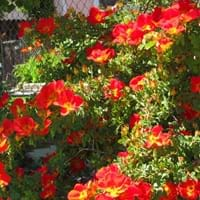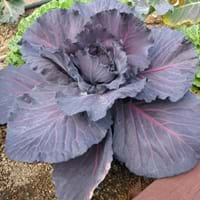Life Span
Perennial
Annual
Type
Flowering Plants, Ornamental Plants, Shrubs
Vegetable
Origin
Not Available
Southern Europe, Western Europe, Mediterranean
Types
Not Available
it is a type of cabbage
Habitat
Foot Hills
agricultural areas
USDA Hardiness Zone
Not Available
Not Available
AHS Heat Zone
Not Available
6-1
Sunset Zone
Not Available
A1, A2, A3, H1, H2, 1a, 1b, 2a, 2b, 3a, 3b, 4, 5, 6, 7, 8, 9, 10, 11, 12, 13, 14, 15, 16, 17, 18, 19, 20, 21, 22, 23, 24
Habit
Clump-Forming
Rosette/Stemless
Flower Color
Orange Red, Yellow
Yellow
Flower Color Modifier
Bicolor
Bicolor
Fruit Color
Non Fruiting Plant
Not Available
Leaf Color in Spring
Green
Dark Green
Leaf Color in Summer
Green, Dark Green
Red, Purple
Leaf Color in Fall
Dark Green
Red, Purple, Burgundy
Leaf Color in Winter
Dark Green
Red, Purple, Burgundy
Leaf Shape
Pinnate
Spinach Type
Plant Season
Spring, Summer, Fall
Spring, Summer, Fall, Winter
Sunlight
Full Sun, Partial Sun
Full Sun, Partial Sun
Type of Soil
Loam, Sand
Loam, Sand
The pH of Soil
Acidic, Neutral
Acidic
Soil Drainage
Well drained
Well drained
Bloom Time
Spring, Late Spring, Early Summer, Summer, Late Summer, Early Fall, Fall
Spring, Late Spring, Early Summer
Repeat Bloomer
Not Available
No
Tolerances
Drought
Drought
Where to Plant?
Container, Ground, Pot
Container, Ground, Pot
How to Plant?
Cuttings
Seedlings
Plant Maintenance
Medium
High
Watering Requirements
Average Water Needs
Do Not over Water, Keep ground moist
In Summer
Lots of watering
Lots of watering
In Spring
Moderate
Moderate
In Winter
Average Water
Average Water
Soil pH
Acidic, Neutral
Acidic
Soil Type
Loam, Sand
Loam, Sand
Soil Drainage Capacity
Well drained
Well drained
Sun Exposure
Full Sun, Partial Sun
Full Sun, Partial Sun
Pruning
Remove damaged leaves, Remove dead branches, Remove dead leaves
Requires very little pruning
Fertilizers
All-Purpose Liquid Fertilizer
All-Purpose Liquid Fertilizer, Fertilize when new
Pests and Diseases
Beetles, Black Spot, Caterpillars, Downy mildew, Mosaic viruses, Powdery mildew, Rust, Scale insects, Thripes
Alternaria Leaf Spot, Anthracnose, Aphids, Bacterial soft rot, Beet armyworm, Black rot, Blackleg, Cabbage looper, Cabbageworm, Clubroot, Cutworms, Damping-off, Diamondback moth, Downy mildew, Flea Beetles, Powdery mildew, Red blotch, Ring spot, Root knot nematode, Slugs, Snails, Thripes, Watery soft rot, White mold, white rust
Plant Tolerance
Drought
Drought
Flower Petal Number
Double
Single
Edible Fruit
Not Available
No
Foliage Texture
Medium
Bold
Foliage Sheen
Glossy
Matte
Invasive
Not Available
No
Self-Sowing
Not Available
Yes
Attracts
Birds, Butterflies
Not Available
Allergy
Rash
Not Available
Aesthetic Uses
Showy Purposes
Not Used For Aesthetic Purpose
Beauty Benefits
Not Available
Not Available
Environmental Uses
Air purification
Air purification
Medicinal Uses
Not Available
Cancer, Detoxifies lever, Glucose
Part of Plant Used
Flowers
Leaves
Other Uses
Oil is used in perfume, soaps, creams, etc.
Culinary use, Used As Food
Used As Indoor Plant
Yes
No
Used As Outdoor Plant
Yes
Yes
Garden Design
Container, Cutflower, Feature Plant, Foundation, Mixed Border, Topiary / Bonsai / Espalier
Bedding Plant, Container, Edible, Herb / Vegetable
Botanical Name
Rosa foetida
BRASSICA oleracea 'Red Express'
Common Name
Austrian briar, Persian yellow rose, Austrian copper rose
Red Cabbage, Red Express Cabbage
In Hindi
Austrian copper rose
लाल पत्ता गोभी
In German
Die Gelbe Rose, Fuchs-Rose, Wachs-Rose, Persische Gold-Rose, Austrian Briar
Rotkohl
In French
Le rosier fétide
Chou rouge
In Spanish
Rosa foetida
Repollo rojo
In Greek
Austrian copper rose
Κόκκινο λάχανο
In Portuguese
Rosa fétida
Red Cabbage
In Polish
Róża żółta
Czerwona kapusta
In Latin
Austrian copper rose
Brassica Rubrum
Phylum
Magnoliophyta
Magnoliophyta
Class
Magnoliopsida
Magnoliopsida
Order
Rosales
Brassicales
Family
Rosaceae
Brassicaceae
Clade
Not Available
Angiosperms, Eudicots, Rosids
Tribe
Not Available
Not Available
Subfamily
Not Available
Not Available
Number of Species
Not Available
Importance of Austrian Copper Rose and Red Cabbage
Want to have the most appropriate plant for your garden? You might want to know the importance of Austrian Copper Rose and Red Cabbage. Basically, these two plants vary in many aspects. Compare Austrian Copper Rose and Red Cabbage as they differ in many characteristics such as their life, care, benefits, facts, etc. Every gardener must at least have the slightest clue about the plants he wants to plant in his garden. Compare their benefits, which differ in many ways like facts and uses. The medicinal use of Austrian Copper Rose is Not Available whereas of Red Cabbage is Cancer, Detoxifies lever and Glucose. Austrian Copper Rose has beauty benefits as follows: Not Available while Red Cabbage has beauty benefits as follows: Not Available.
Compare Facts of Austrian Copper Rose vs Red Cabbage
How to choose the best garden plant for your garden depending upon its facts? Here garden plant comparison will help you to solve this query. Compare the facts of Austrian Copper Rose vs Red Cabbage and know which one to choose. As garden plants have benefits and other uses, allergy is also a major drawback of plants for some people. Allergic reactions of Austrian Copper Rose are Rash whereas of Red Cabbage have Not Available respectively. Having a fruit bearing plant in your garden can be a plus point of your garden. Austrian Copper Rose has no showy fruits and Red Cabbage has no showy fruits. Also Austrian Copper Rose is not flowering and Red Cabbage is not flowering . You can compare Austrian Copper Rose and Red Cabbage facts and facts of other plants too.





